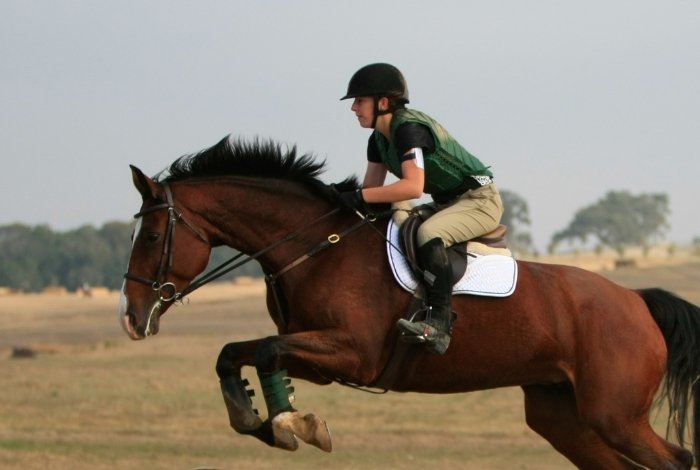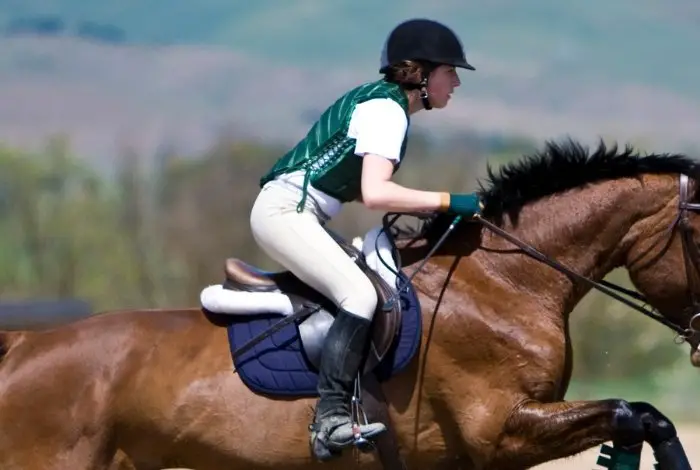Last Updated on February 27, 2023
When considering an air vest for horse riding, searching the options available can be overwhelming! We’ve done the hard work for you, trawling through the equestrian air vest reviews 2023 to help you choose!
It is no secret that horseback riding can be a highly dangerous sport. Horse riding is considered more dangerous than football, skiing, and even motorcycle riding.
Due to the increased risks involved with equestrian sports, advancements in safety technology produce new and innovative cutting-edge protective gear each year. Among these advancements, air vests have grown in popularity as more brands release their own versions in a variety of styles with different ratings.
When looking for a new air vest for horse riding, it can be hard to figure out which is the best option available. To help you out, we’ve looked at all major brands and their equestrian air vest reviews in 2023, to pick out the top three on the market right now.
What Are Equestrian Air Vests?
Although there is some variation among air vest designs, the principle of these products remains the same. An equestrian air vest is an inflatable horse-riding safety vest. They have some form of mechanism, usually a string attachment to a saddle, which activates a trigger when the rider departs the saddle.
This will cause the inflatable equestrian vest to fill with air immediately, in the same way, that an airbag inflates in a car. The method of inflation is usually from a punctured air canister activated by the string.
Most equestrian air vests are designed to stabilize the neck, and head, and create a soft protective barrier around the torso. This allows for a cushioned impact and reduces the risk of injury, particularly around the chest and sternum.
Air vests can be worn alone or with a body protector; pairing the air vest with a traditional body protector provides optimal injury prevention, and is becoming the gold standard combination for high-risk equestrian sports. This is why a lightweight and adjustable vest is greatly preferred for layering purposes, especially in the summer months.
It is important to note that if you fall off your horse and the air vest is inflated, the mechanism will need to be reset before the vest is worn again. This is normally very easy to do, and most manufacturers sell spare CO2 cartridges for this purpose. If cared for correctly, a good air vest should last for many years of use, providing you with enhanced protection in the event of a fall.
Air Vests vs Body Protectors
Before the emergence of equestrian air vests, traditional body protectors dominated the market. Body protectors are worn during rides but do not change in any way upon impact. They feature a lightweight and comfortable foam interior to help minimize impact when a rider hits the ground or an object.
They protect the core, helping minimize or eliminate rib, chest, and internal injuries. Unlike their inflatable counterpart, they do not offer neck or spinal protection. Air vests aim to decrease the severity or “crushing” injuries, particularly during hard impact or injuries involving the horse itself.
Regular body protector vests are normally a mandatory requirement for high-risk equestrian sports such as cross-country jumping competitions. Although air vests are not a mandatory requirement, they can be used with a traditional body protector to reduce the risk of injury still further. It is vital to remember that air vests are not a substitute for a body protector.
For competition purposes, an air vest can be worn over a BETA Level 3 or SEI-certified body protector. Ideally, body protectors will attach to the air vest to prevent movement in a rotational fall.
Find The Best Equestrian Safety Vests Reviews
What Are Equestrian Air Vests Used For?
Air vests can be used in any type of riding, although some competitions may have specific rules or requirements. They are traditionally seen in the cross-country portion of three-day eventing. Cross-country jumping is a dangerous high-speed jump course where riders must navigate complex jumps and natural obstacles. The courses involve mixed terrain, watercourses, and solid jumps (as opposed to collapsible fences).
One of the reasons air vests are more common in cross-country and other jumping courses is due to the high-risk nature of any fall that occurs during these pursuits. The horse will likely be traveling at high speed and the rider can fall from a greater height if the horse is going over a jump, both of which increase the strength of any impact with the ground. It is also possible that the rider could land on a hard object such as the jump, or the horse could accidentally injure the rider should they also trip.
Outside of competitions, many instructors require students to utilize air vests or regular body protectors when starting to jump. Some training facilities also incorporate the use of air vests in their regular lesson programs.
Equestrian Air Vest Safety Ratings
As equestrian inflatable air vests are still relatively new to the market, they are not yet subject to the same safety ratings as traditional body protectors. Body protectors fall under three international safety standards, but there is no current international standard for air vests.
The key safety ratings to look out for on body protectors are CE EN 13158, ASTM F1937, and ASTM F2681. Another common rating system was developed by BETA, with simple level 1, 2, or 3 ratings.
The only current rating for equestrian air vests is the European (EN) SATRA M38 standard. Over time, it is highly likely that more stringent safety standards for equestrian air vests will be developed, allowing riders to feel confident in their choice of air vests.
Do Air Vests Really Work?
As of now, little is known about the actual safety and efficiency of air vest usage. Studies are ideally performed with minimal to no change in variables, which is almost impossible to control when conducting field studies on accidents involving independently moving and thinking humans and horses together.
The International Research Council on the Biomechanics of Injury Conference showed 2016 study results indicating air vests reduced serious chest injury by a mere 13%. However, this study used a deceased equine cadaver being dropped on a dummy.
In studies conducted from FEI statistics and injury reports, the Journal of Science and Medicine in Sport found air vests were actually associated with higher injury percentages! However, many experts believe this is due to the level of competitors typically utilizing air vests – they are more injury-prone due to the level of competition, and may have had a more brazen approach to riding than someone without the added protection.
Air vest users were found to have 1.7 increased odds of serious or fatal injury in comparison to riders without one. However, experts all agree there is significantly more work needed to solidify any of these studies. The variables and biomechanics of any individual fall can vary greatly. This makes any realistic case study nearly impossible to repeat without major changes to the variables. The science of safety remains the same, offering additional core and spinal protection.
Top 3 Equestrian Air Vest Reviews 2023
Are you a top-level cross-country rider, or looking for extra safety precautions to wear alongside your body protector? The recent explosion in the popularity of air vests for horse riders has led to the market being saturated with new products, making it difficult to pick out the very best options to buy. Luckily, we’ve taken an in-depth look at many equestrian air vest reviews in 2023, to help you decide!
These are our top three picks in air vests for horseback riding:
#1 Ovation Air Tech Vest
The Ovation Air Tech Vest is one of the most affordable air vests on the market – although you can’t put a price on safety, affordable products such as these make this essential piece of safety equipment available to many more riders!
This vest uses a CO2 trigger system to help decrease injury risk – if the rider is dislodged from the saddle, the vest fills with air in a split second. It features reinforced tubes making it more durable, and it is ultra-lightweight and comfortable. Available in both adult and children’s sizes, this air vest is a great option for layering over other traditional body protectors.
Pros:
- Economical by comparison
- Lightweight
- Children’s and adult sizes
Cons:
- No SATRA rating
- Warm when riding
- Frequently sells out and restocks are quick to go
#2 Hit-Air Lightweight Air Vest
The Hit-Air Lightweight Air Vest uses a 48cc CO2 cartridge with a fast key ball mechanism for high-speed airbag deployment. The design is a harness-type one-size-fits-all style, and weighs only 1.9 pounds!
The cut of the LV model makes keeps riders cool even in summer months or when layered with a body protector. It has a quieter mechanism when deployed, reducing the risk of the horse spooking at the noise of the vest inflating. This vest is a good option for lesson programs that accommodate multiple students of varying sizes.
Pros:
- Economical
- Great for summer months
- Adjustable fit for multiple riders
Cons:
- No SATRA rating
- Limited size range
#3 Point Two Pro Air Hunter Air Vest
The Point Two Pro Air Hunter vest is extremely lightweight and is the most popular edition of the Point Two air vest collection. Its design has rider comfort in mind, featuring adjustable straps and an extended tail for lower back, coccyx, and kidney protection.
The Pro Air design is worn alone or with a traditional body protector, but be sure measurements are accurate and compatible with how the vest is going to be worn. It is slightly bulkier than other air vests on the market, and may not be as comfortable in warmer weather.
Pros:
- Very lightweight
- High comfort factor
- Extended tail portion for additional protection
Cons:
- More expensive by comparison
- Not suitable for Western riding styles
Bonus Review! The Helite Equestrian Air Vest
The Helite equestrian air vest provides high-volume protection of up to 28 L depending on the size of the airbag/vest. When deployed, the system can be reactivated in less than 2 minutes! These vests boast a 2-year guarantee and possess certification by the Alienor Laboratory, an organization that rates and certifies PPE as an independent body. A 4-year warranty is also available for purchase. The detection inflates in 100 ms and uses an adjustable fit system with superior neck protection and stability.
Pros:
- Has a lab certification for PPE
- Lightweight
- Adjustable fit
- Warrantied with optional extended warranty
Cons:
- Not normally sold/shipped from all countries
- More expensive by comparison
Final Thoughts – Air Vest for Horse Riding
Purchasing an air vest for riding can be a difficult decision due to the large price tag and variable design features of this product line. Although studies have shown the increased safety provided by wearing an air vest, there is not yet a real-life evidence base to back this up. For this reason, most manufacturers recommend that you should pair your new air vest with a traditional body protector to get the most out of your injury-prevention gear. If you are riding cross-country and already wearing a top-quality body protector, an air vest will take this to the next level.
If you’ve got friends with horses, especially jumpers, be sure to share this article! The above list may help someone with their holiday gift shopping this year!
Equestrian, Marine Corps vet, and Morgan horse enthusiast.






